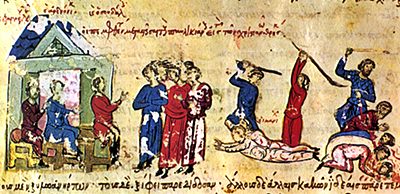
Battle of Bathys Ryax |
year: 872872 (or 878) |
| Victory of the Byzantines against the Paulician heretics | ★ ★ ★ ★ ★ |
|
enemy: Paulicians
|
location: At Bathys Ryax (meaning “Deep Stream” in Greek) in modern Kalin Irmak pass west of Sivas in Turkey.
|
accuracy:
●●●●●
|
|
battle type: Surprise Attack |
war: War against Paulicans |
modern country:
Turkey |
| ▼ The Byzantines(emperor: Basil I the Macedonian) | ▼ The Enemies | |
| Commander: | Chistoforos | Chrysoheir |
| Forces: | Unknown | Unknown |
| Losses: | Completely destroyed |
| Background story: |
| The Paulicians were a Christian-Gnostic sect with obscure beliefs and origins, in eastern Anatolia. They were fiercely iconoclastic, adhered to a very distinct Christology and rejected the authority and practices of the official Byzantine Church. Consequently, they were persecuted by the Byzantine state as early as 813. The persecutions were intensified after the end of the official Iconoclasm in 843. Up to 100,000 Paulicians had been massacred, in an unprecedented attempt in Byzantine history, to eradicate an entire heretical sect. The survivors fled and found refuge in the neighboring Arab emirates. With the support from of the emir of Melitene, Omar al-Aqta, the Paulician leader Karbeas founded a separate principality at Tephrike, and for the next decades, the Paulicians were allied with Arabs against Byzantium and gradually became a serious threat. The Paulicians suffered a critical blow in 863 in the battle at Poson, but under their new leader, Chrysocheir, they resumed raids deep into Byzantine Anatolia, raiding as far as Nicaea and sacking Ephesus in 869/970. Basil I the Macedonian, led a campaign against the Paulician state in the spring of 871, but was defeated and only narrowly managed to escape himself. Encouraged by this success, Chrysocheir then staged another deep raid into Anatolia, reaching Ancyra and ravaging southern Galatia. Basil reacted by sending his brother-in-law, Christopher, against them. The Paulicians managed to avoid a clash, and as the campaigning season drew to a close, they began retiring towards their territory. |
The Battle: |
 Persecutions of Paulicians When this unit reached the pass, night had fallen, and the Paulicians, apparently unaware that they were being followed, had made camp in the valley of the pass. The Byzantines took up position in a wooded hill overlooking the Paulician camp, still unnoticed by the enemy. At this point, the two generals decided to take advantage of the opportunity and attack, despite their orders. A detachment of 600 men launched a surprise attack at dawn, while the rest remained behind and made loud noises with trumpets and drums, so as to suggest the imminent arrival of the entire Byzantine army. The ruse worked perfectly: the Paulicians, taken by surprise, panicked and dispersed without any serious resistance. The Paulician rout was completed as they fell upon the main body of the Byzantine army while fleeing. Their remnants were pursued up to a distance of 50 km. Chrysocheir himself managed to escape with a small group of bodyguards, but he was arrested later. He was beheaded, and his head was sent to Emperor Basil in Constantinople. |
Noteworthy: |
| The resettlement of the remaining Paulicians in the Balkans is one of the factors that influenced the development of the heresy of the Bogomils in Bulgaria, in the 10th century (although the two heresies were quite different). |
Aftermath: |
| Bathys Ryax was the end of the Paulicians as a military power and a threat to Byzantium. Basil followed this success by a series of campaigns against the Paulician strongholds. Tephrike was captured in 878 and razed to the ground. |
|
|
